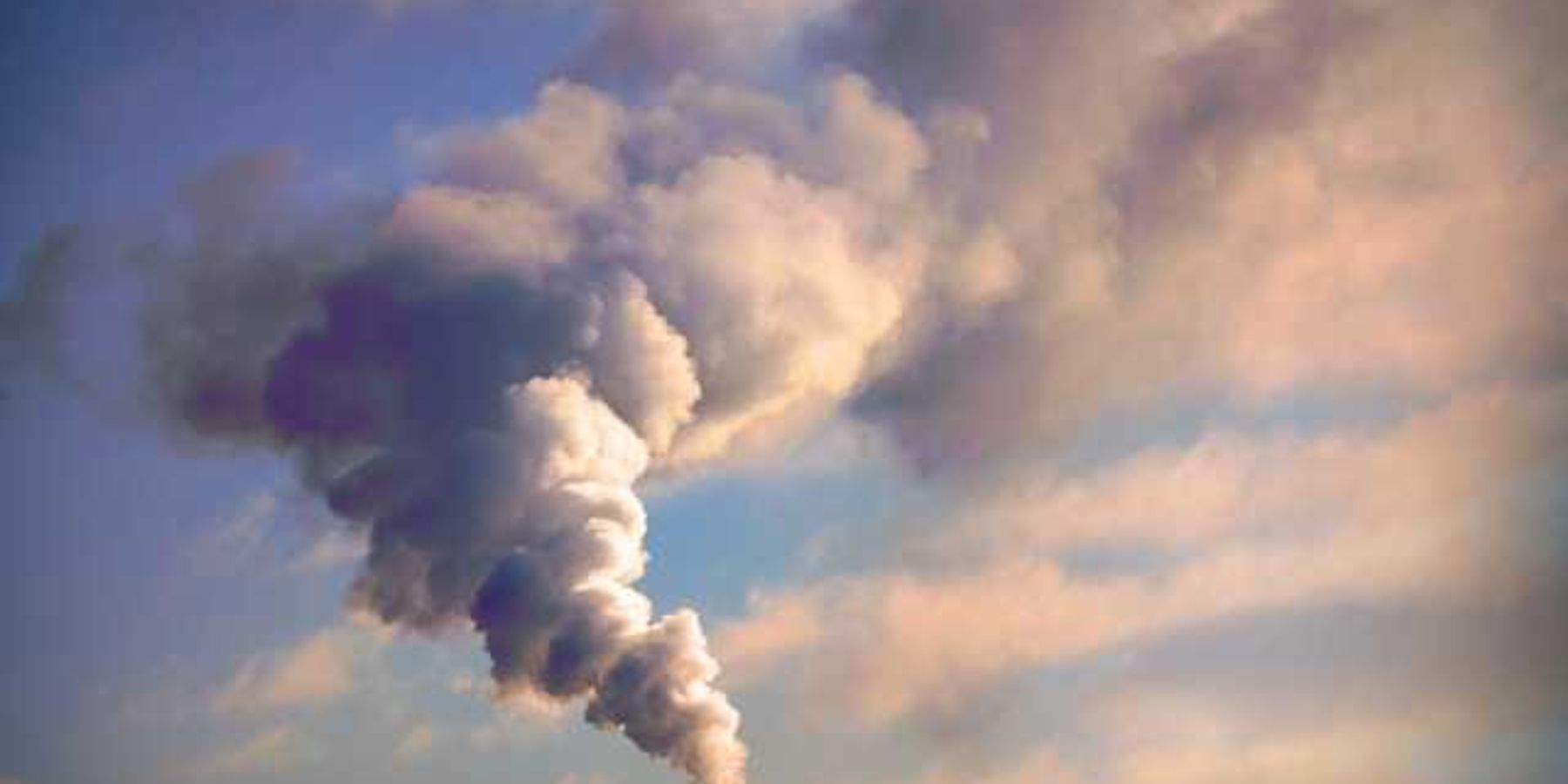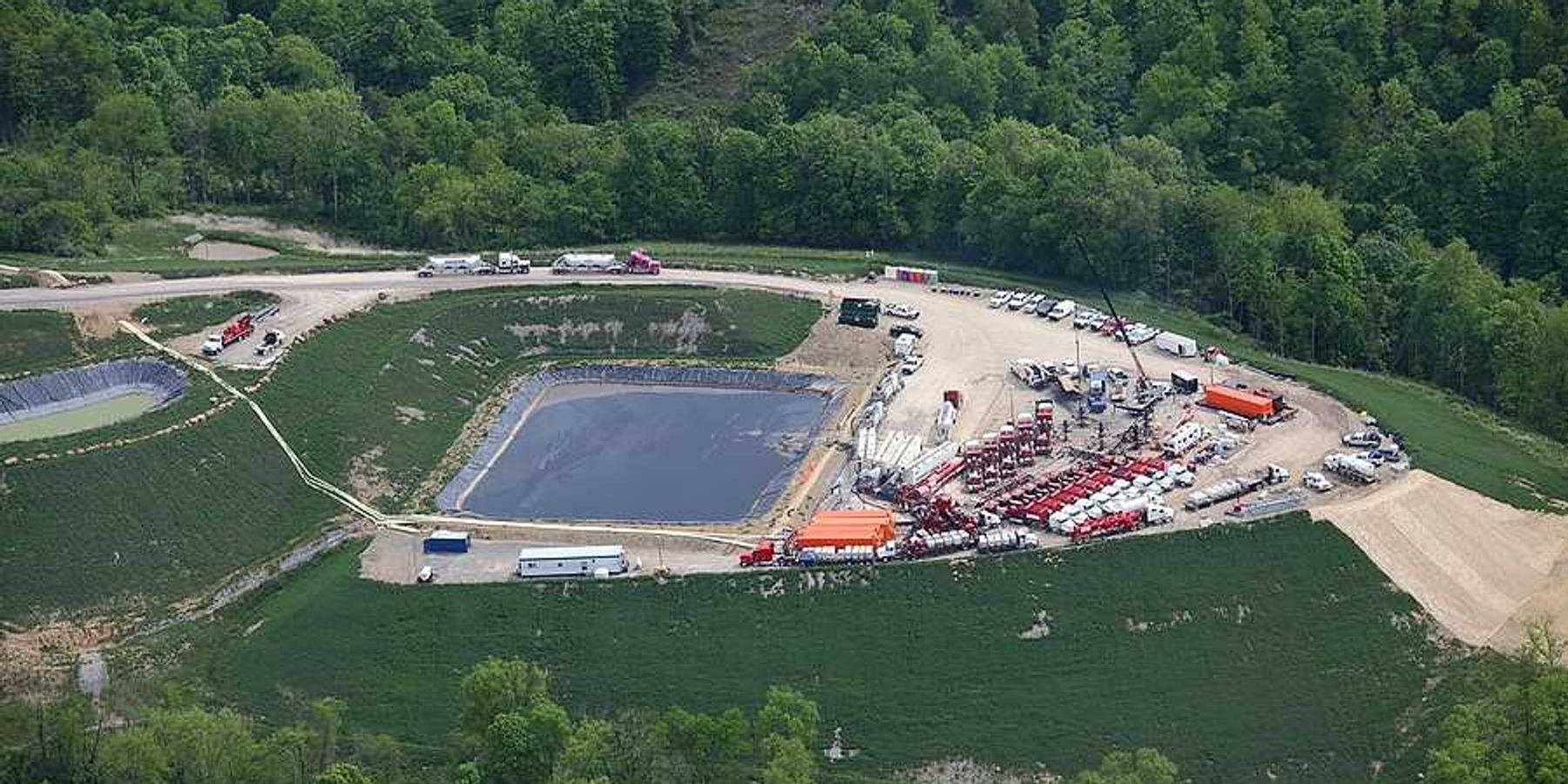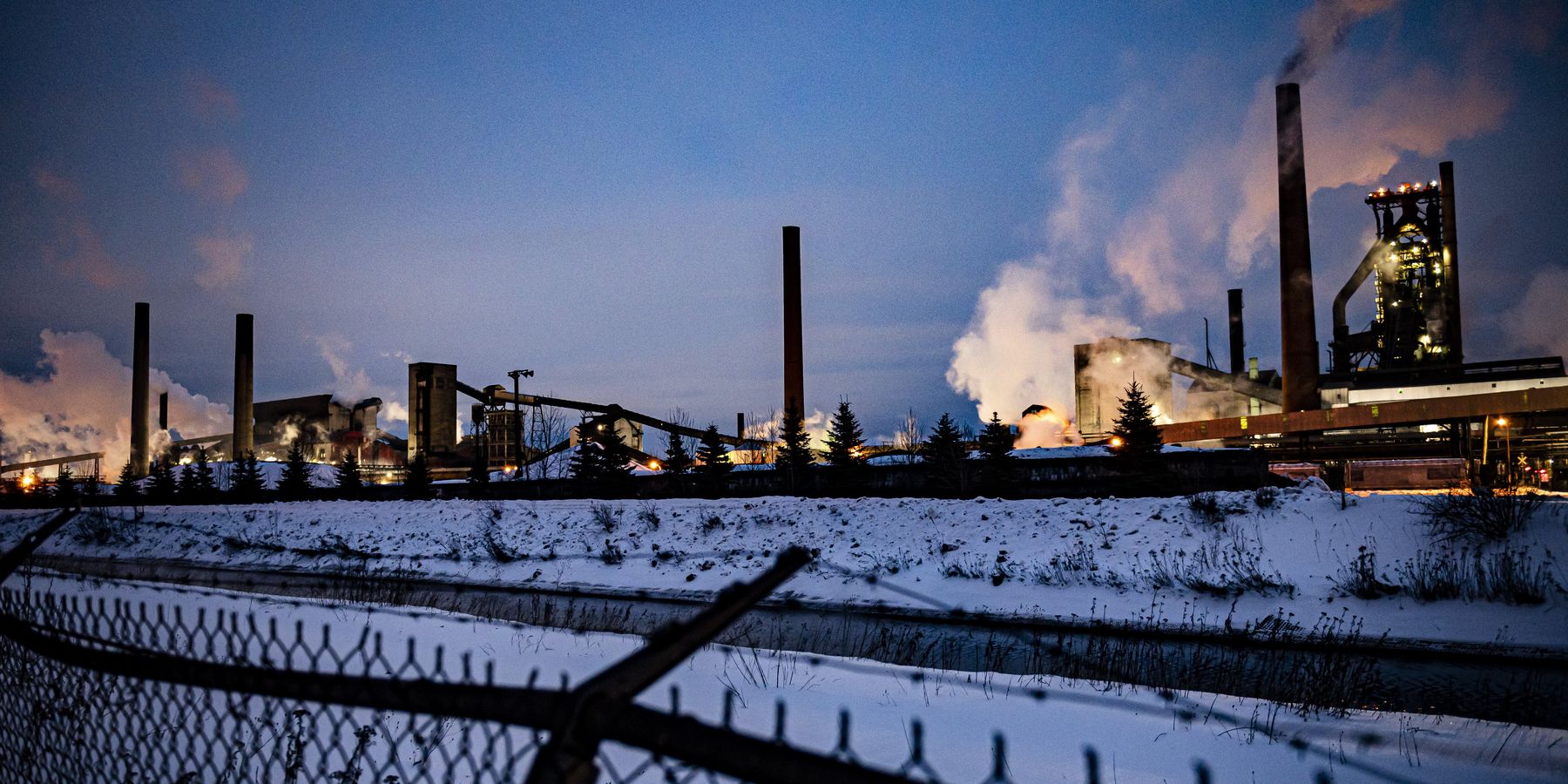
Cleaner steelmaking can’t come fast enough for this Northern Ontario city
Algoma Steel continues to exceed Canada’s standard air pollution limits for cancer-causing compounds and struggles with spills as it pushes toward a “green” makeover.
SAULT SAINTE MARIE, Mich. — Peter McLarty technically stopped teaching science in 2000. But the retired high school teacher continues to educate — only now it’s about the dangers of a massive steel-making plant in his Northern Ontario community.
McLarty, a member and vice chair of Clean North, an environmental advocacy organization in Sault Sainte Marie, Ontario, was unsurprised when, once again, a failure at the Algoma Steel plant led to pollution discharge into the St. Marys River.
“The only time the public pays attention is when pollution goes into the water,” McLarty told Environmental Health News (EHN). “The community wakes up, there’s media coverage but then it all dies off again.”
The smoke-belching mass of buildings, pipes, furnaces and flares sit on the banks of the St. Marys River, which holds economic, ecological and cultural importance for the two cities it bisects: Sault Sainte Marie in Ontario, Canada, and the city of the same name across the water in Michigan’s Upper Peninsula.
The river is one of the most engineered in the United States. A series of locks — the “Soo Locks” — allow an ever-growing number of cargo-hauling freighters to travel from Lake Superior down the river to Lake Huron and beyond. But the re-shaping goes beyond past and current lock construction, in the form of planned and unplanned pollution.
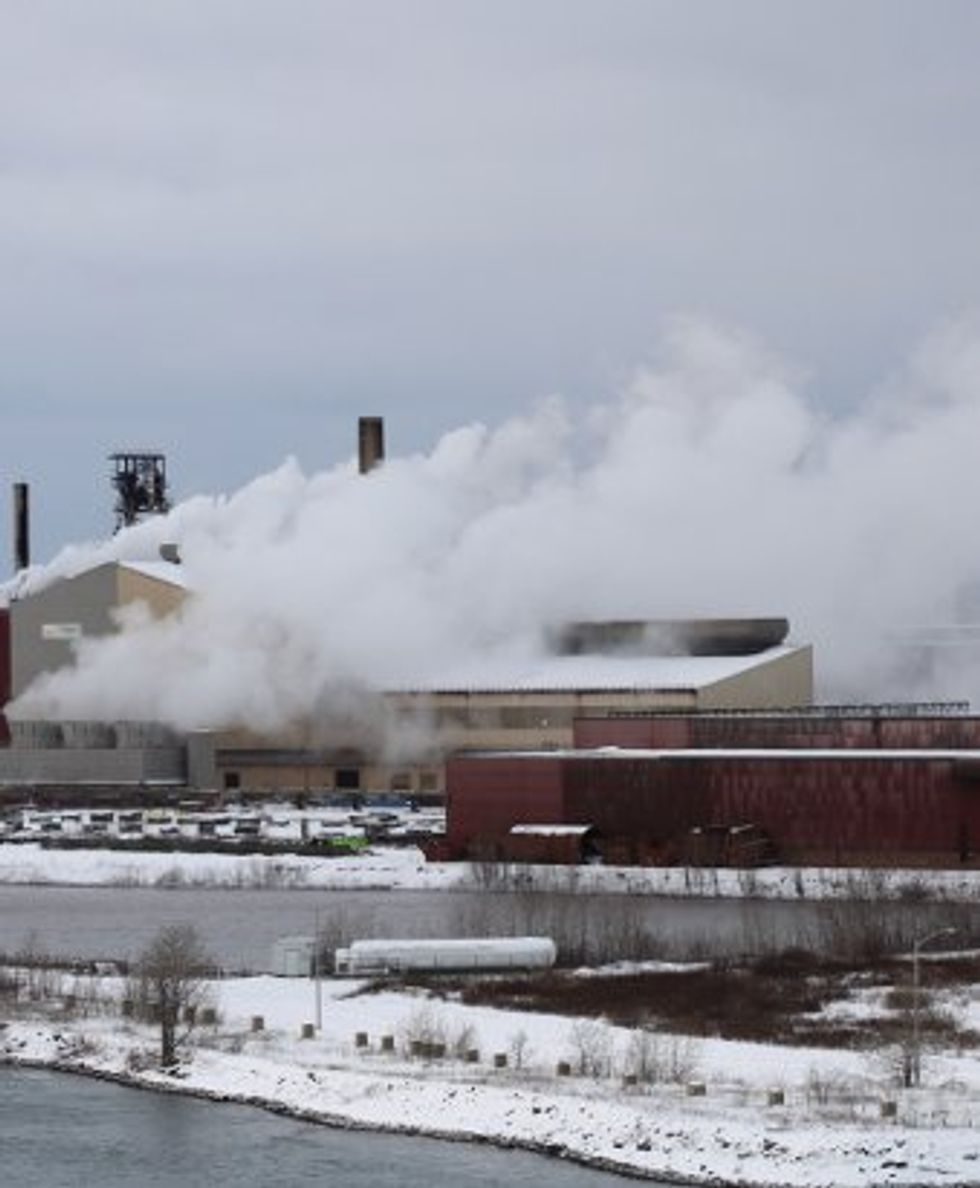
Algoma Steel emissions in February 2024.
Credit: Brian Bienkowski/EHN

Peter McLarty
Photo courtesy of Peter McLarty
This pollution seeps into the water of the St. Marys River, affecting communities downstream, but also invades the air of neighboring communities in the form of benzene, particulate matter and other toxic compounds. Despite being authorized to emit higher levels of pollution than what’s usually allowed, the plant routinely violates these limits. Partly funded with taxpayers money, the company has promised it’ll phase out coal-based steelmaking by 2029. But until then, nearby communities — already struggling with elevated rates of cancer and other illnesses — will have to deal with air and water contamination.
Algoma Steel’s own modeling estimates they’ve sent thousands of tons of harmful compounds into the waterway over the last decade, with legal permission to do so. But it’s the unplanned spills and accidents that catch the public’s eye. The company has had two contractors die onsite in the past two years. In mid-February, a blast furnace explosion sent five employees to the hospital when they, along with 7 others, were burned with molten metal. Three weeks earlier, piping at the plant collapsed — contaminating the river even further.
These incidents came on the heels of a June 2022 oil spill at the plant, which sent roughly 2,000 liters of oil into the river, prompting a drinking water advisory from Algoma Public Health, the district health authority. The spill shut down shipping on the St. Marys River and caused the Echo Bay community, which is a few miles downriver of the plant, to shut down their water treatment plant for 18 days. Michigan also issued a health advisory for Sugar Island, which is in the St. Marys River downstream of the plant.
But the water isn't the only resource that’s been polluted. The plant has legal permission to emit more particulate matter pollution and the cancer-causing substance benzene than what’s allowed under law. They are also the second largest greenhouse gas emitter in Ontario, and the eleventh largest in all of Canada. EHN, along with The Narwhal, documented this cross-border pollution in 2020 — outlining the air and water pollution from the plant, coupled with higher than average cancer rates on both sides of the river.
“We’re hollering but nobody’s listening,” McLarty said.
Algoma Steel initially welcomed questions from EHN but once the questions were sent, they did not respond. However, the Ontario Ministry of the Environment, Conservation and Parks, which is charged with regulating Algoma Steel and has repeatedly allowed pollution exceedances, point to a massive overhaul at the plant that will retire its polluting coal-based coke-making, switching to an electric arc furnace system.
For McLarty and others concerned about their health, the switch can’t come fast enough.
Aging infrastructure and ongoing pollution
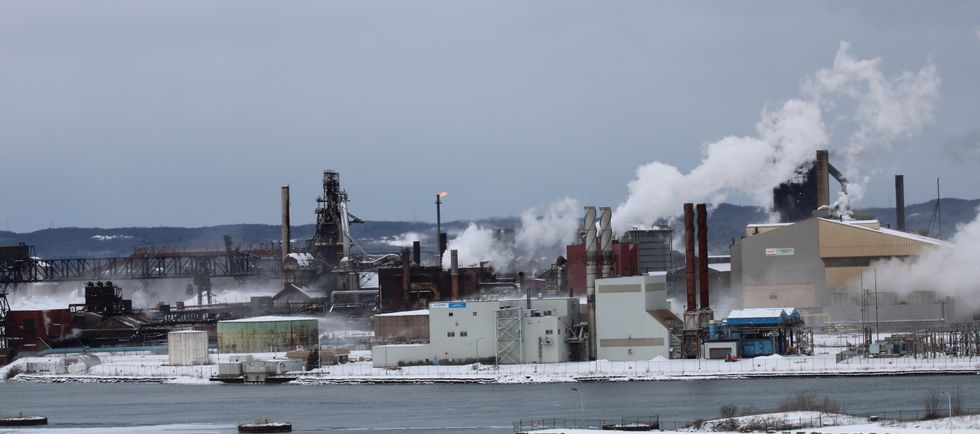
Algoma Steel pictured in February 2024. For years the plant has legal permission to emit more particulate matter pollution and the cancer-causing substance benzene than what’s allowed under law.
Credit: Brian Bienkowski/EHN
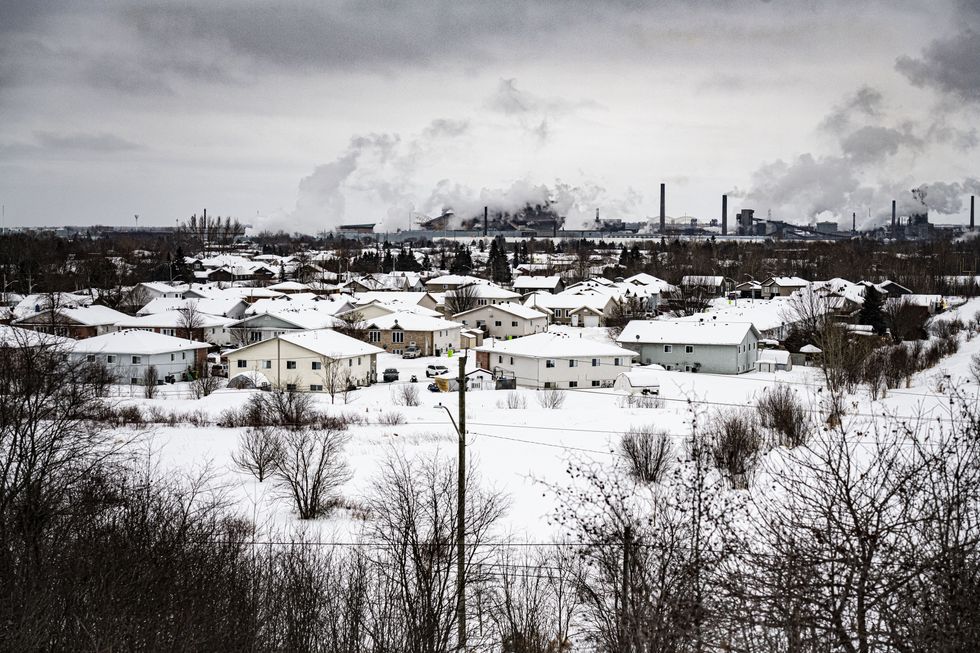
View of Algoma Steel emissions from nearby neighborhoods. Pictured in 2020.
Credit: Christopher Katsarov Luna/EHN
On January 20, Algoma Steel reported a “collapse of structure supporting utilities piping” at their coke-making plant (coke is a key ingredient in steelmaking that involves heating coal to extremely high temperatures). The company was forced to shut down coke production for nearly three weeks after the accident.
As a result, an unknown amount of flushing liquor was released into the St. Marys River, Gary Wheeler, a spokesperson with the Ministry of the Environment, Conservation and Parks, told EHN. Flushing liquor is used to cool coke oven gas, recover valuable chemicals and remove sticky and corrosive components created in the coke-making process, he said.
The main contaminants in flushing liquor are ammonia and phenols, Wheeler said. The Ministry hasn’t found any aquatic impacts yet, but is reviewing water samples taken.
The pipeline break, and 2022 oil spill as well as all the other accidents, are linked to the plant’s aging infrastructure, McLarty believes. “This incident could have happened anytime and can happen again because of [it],” he said.
“We’re hollering but nobody’s listening.” - Peter McLarty, Clean North
These incidents come in addition to the tons of legal pollution that Algoma sends into the St. Marys River each year. In 2022 (the most recent year with available data), company modeling estimates it discharged more than five tons of zinc, 13 tons of ammonia, which is toxic to aquatic life; 211 pounds of lead, which is considered unsafe at any level in drinking water; 1.5 tons of manganese, which damages the nervous system at high level; and 109 tons of nitrate, which has been linked to cancer, reproductive problems and birth defects when found in drinking water.
According to an EHN analysis of Algoma Steel’s annual modeling data, over the past decade the company has poured into the St. Marys River more than 430 tons of ammonia, nearly three tons of benzene, 4,600 pounds of lead, 18 tons of manganese, 2,367 tons of nitrates and 55 tons of zinc.
This is on top of the air pollution Algoma Steel spews from its stacks every year. In 2022, the company estimates it emitted more than six tons of benzene, more than 1,000 tons of nitrogen dioxide and more than 170 tons of particulate matter, along with other harmful air contaminants.
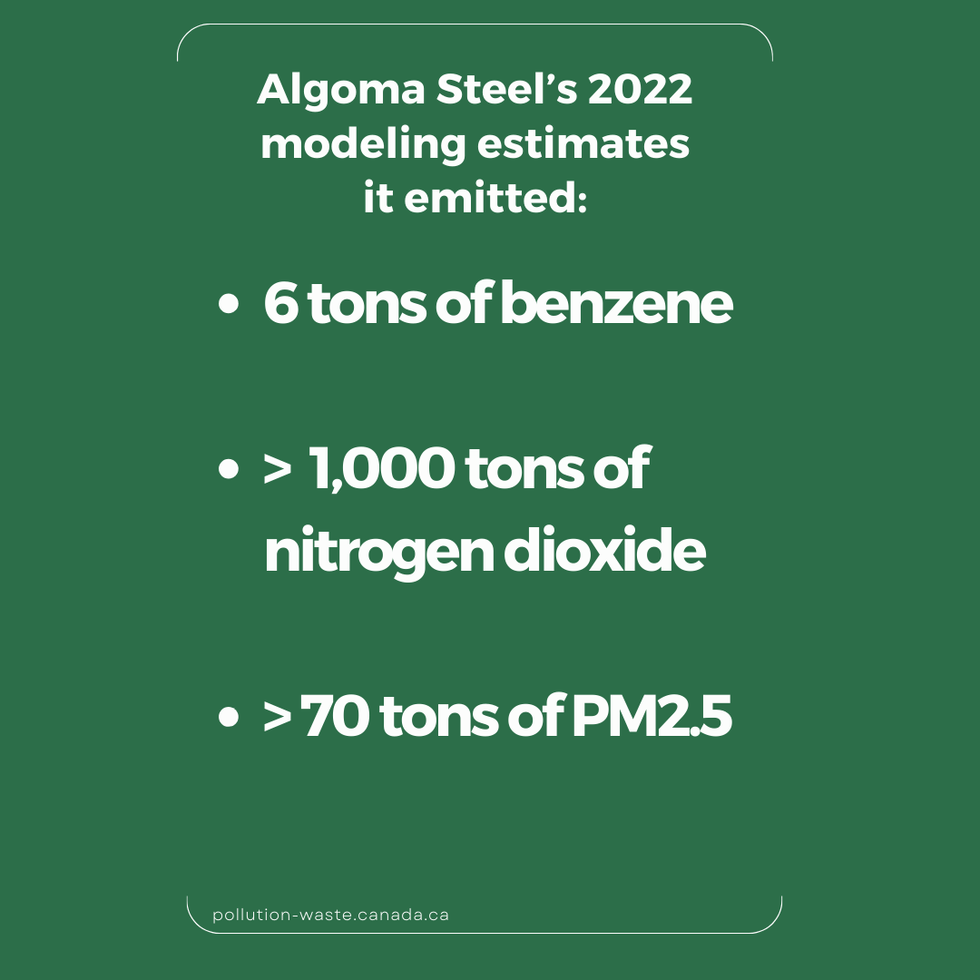
For some of these pollutants, like benzene, benzo(a)pyrene and particulate matter, the company has operated under a “site specific standard” — which allows the company to emit beyond legal limits. Wheeler said companies can get this type of permit when there are “limitations in technology or potential economic considerations.”
As a result, the plant has a pass to emit benzene and benzo(a)pyrene to nearby air five times and 400 times higher, respectively, than the province’s standard. This has led to situations where neighborhoods in Sault Sainte Marie, Canada, receive amounts of benzo(a)pyrene up to 324 times higher than air quality regulations, according to an investigation from the National Observer last year.
Although the plant’s standards expired in 2023, the Ministry is reviewing another round of requests from Algoma Steel, including a new requested site-specific standard for sulfur dioxide, Wheeler said.
While this process of giving a special permit to the company is public, a review of the last consultation found that residents raised concerns about how short the public comment period was and what health impacts the company’s ongoing pollution has in the community. McLarty also pointed out that Algoma Steel’s own environmental incident reports show “daily violations of regulations.”
Wheeler said the eventual electric arc furnace overhaul at the plant should remove the need for these air pollution exceedances.
“Algoma anticipates it will meet Ontario’s air standards at the completion of this transition,” he said, and added that the proposed plan “will significantly reduce benzene, benzo(a)pyrene, sulfur dioxide emissions, and other contaminants including greenhouse gases, and have a substantial positive impact on air quality in the local community.”
In the meantime, health problems plague the community.
Health problems

The international bridge connecting Sault Sainte Marie, Michigan, to the city of the same name in Canada. The St. Marys River is one of the most engineered rivers in the United States.
Credit: Christopher Katsarov Luna/EHN
While scientists can’t pin specific cancer cases on nearby pollution, benzene is a known carcinogen and benzo(a)pyrene is a probable carcinogen. Particulate matter and nitrogen dioxide have been linked to cancers as well. As EHN previously reported, the Sault Sainte Marie area has the highest age-standardized rate of cancer in Ontario and the highest provincial rates of lung and prostate cancer. The city’s P6C postal code — which is the western end of the city that borders Algoma Steel — has double the national rate of rare acute myeloid leukemia, and a 2019 study found “disease clusters” of the leukemia in four industrial border cities, including Sault Sainte Marie.
Algoma Public Health did not respond to questions specific to community concerns about the plant’s pollution. Rather, Dr. Jennifer Loo, medical officer of health for Algoma Public Health, pointed out that the agency “does not have a role in assessing compliance with or enforcing environmental regulations” and “continues to liaise with local partners who are monitoring this incident [the recent piping collapse], and we will issue any public health updates as necessary.”
“Algoma anticipates it will meet Ontario’s air standards at the completion of this transition." - Gary Wheeler, Ministry of the Environment, Conservation and Parks
Matthew Shoemaker, the mayor of Canada’s Sault Sainte Marie, told EHN he recognizes and understands “the concerns of community members about industrial pollution and the impacts on the environment and community members,” but that the city can’t take any regulatory action when there are spills or other environmental violations, as that falls to the Ontario Ministry of the Environment, Conservation and Parks.
Algoma Steel has three published violations from the Ministry, according to Wheeler — a $75,000 fine in 2008 for discharging a phenol over allowed limits; a $125,000 fine in 2016 for neglecting to report a spill incident; and a $181,250 fine in 2023 for a 2019 discharge that exceeded allowable levels of phenol, cyanide and ammonia. They have yet to be fined for the 2022 oil spill.
Algoma Steel reported nearly $300 million in net income in the fiscal year 2023.
Greener steelmaking
In 2021, the Canadian federal government announced Algoma Steel was awarded $420 million of federal funds to “green” its steelmaking process by retiring the polluting, aging coke ovens and switching to electric arc furnaces for steelmaking. It is part of an estimated $700 million makeover that will significantly reduce pollution at the plant.
The company estimates the switch, scheduled to begin this year, will cut the company's carbon emissions by about 70% and many of the harmful pollutants like benzene and particulate matter as well. Previous statements from the company suggest they expect to be completely off the current coal-fired furnaces by 2029.
When other coke-processors have shut down, there have been massive health benefits to nearby communities. For example, after Pittsburgh’s Shenango Coke Works shut down, weekly hospital visits among residents in neighborhoods surrounding the plant for heart-related problems decreased by 42%. Previous research found ER visits for asthma near the plant dropped 38% after it shut down.
McLarty is cautiously optimistic about the electric arc switch, but remains concerned as long as the coke ovens are in use and polluting the community.
“The problem all along is a lack of maintenance,” he said. “That’s how they end up having these disasters.”


